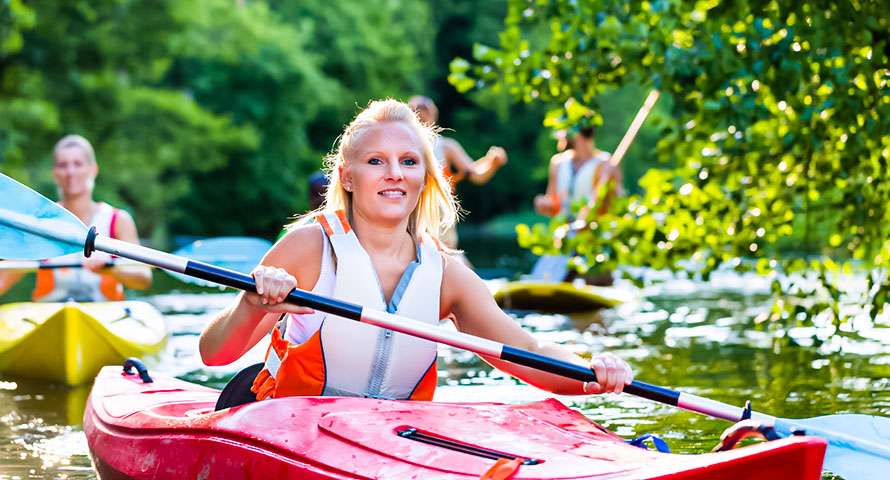In many parts of North America moving water is the norm. Whitewater and tranquil ponds may be hours away, but gently moving current is often right at paddlers’ fingertips. Coastal areas like the Southeast have waterways that remain motionless until a big rain; as rainwater drains, however, their once docile waters become alive with flow. With no great rocks to dodge or hydraulics to negotiate, moving water lies in that often-neglected, in-between world of not quite being one type or another.
Moving Water
It’s a black and white world: most kayakers describe themselves as either whitewater or quietwater paddlers. A lot of fun can be had, however, on water in between these two extremes water that is not aerated and dotted with obstructions, or still and featureless. Moving water, the wayward stepchild of whitewater and pushy cousin of quietwater, allows paddlers a chance to exercise high-level skills; it can be more forgiving than whitewater, and more interesting than quietwater.
It’s also easier logistically. Equipment is simpler, with most moving water paddlers using lighter quietwater canoes and paddles: no flotation bags, no reinforced, rock-proof paddles. Throw bags are optional, as are helmets and river knives. There also are fewer items to transport from the car down to the river, and shuttles are frequently a convenience, not a necessity. Many moving water rivers are easily paddled upstream, yielding more time on the water. Advanced quietwater technique can be put to good use, with moving water allowing paddlers to still move around in their boat. With no pedestal or straps locking you in place, a variety of kneeling positions – high kneel, cross high kneel or transverse–helps eliminate fatigue and sore muscles.
Unlike whitewater, most moving water is forgiving enough to allow paddlers to play with a decreased probability of mishap. This gentler character gives time to practice skills at handling current with little fear of swimming; basic eddy turns, peel-outs and ferries can be perfected. Moving water encourages experimentation and helps paddlers gain confidence.
One technique that will help you stay dry on moving water is to heel (lean the boat) downstream. As in whitewater situations, it’s best to heel downstream (down current) during a turn or a ferry. Most paddlers can get away with a level or slightly upstream-heeled boat on moving water, but moving water can grab the upstream side of the canoe.
Helpful Techniques
Combining an appropriate heel with a few static placement turns will make life easier. An easy first move is called an axle. Use an axle to turn into an onside eddy, a cross-axle to turn into an offside eddy. Frequently, eddies in moving water are not well defined; a rock, stump or bend in the river may simply create a gentle back flow that can provide a restful pause.
To execute an axle, paddle downstream toward the downstream side of an eddy-causing river feature on your onside. As the bow crosses the eddyline, heel to the onside (remember, axles are used for onside turns), start the turn with a hard “J” or “C” correction at the end of the last forward stroke, then use a static placement – such as a turning high brace, a hanging draw or Duffek – using about a 45-degree open blade angle. Place the blade just in front of the onside knee and maintain the onside heel throughout the turn. Conclude the turn by converting the static placement into a bow draw.
Think offside for a cross-axle, which will help get the canoe into an offside eddy. As with an axle, paddle downstream and head for the top of an offside eddy. As the bow crosses the eddyline, start the turn with a hard-forward stroke or a sweep, heel the kayak to the offside and plant a cross-turning high brace. Conclude the turn with a cross bow draw.
Mid-current Turns
Most moving water provides the luxury of mid-current turns, enabling paddlers to turn back upstream without getting into an eddy. Keeping in mind the need to lean the kayak (not your body) down current, use a post to complete a mid-current turn to your onside. A post is similar to an axle: same initiation, static placement and conclusion. It is different in that the canoe is heeled away from the paddle, to the offside. The post usually produces a sharper turn than an axle, and it keeps the boat heeled downstream.
To execute a mid-current turn to the offside, use a cross post. The elements of the move are the same as in the cross axle, just heel the boat away from the paddle placement toward the onside. Again, the kayak will be leaned downstream. Mid-current turns paddling upstream are accomplished using axles for onside turns and cross axles for offside turns.
For faster, more acute mid-current turns, try using a wedge or cross wedge. A wedge combines a downstream boat heel with a static placement called a jam, executed by placing the blade in the water against the side of the kayak at the onside knee. The leading edge of the blade should be angled in toward the hull about 20 to 30 degrees. The control hand thumb can be pointed forward toward the bow or back toward the shaft hand shoulder. Use a wedge for a mid-current turn to the offside. Start the turn by doing a hard-forward stroke or a sweep, then slice the paddle into a jam. The kayak will turn sharply upstream. Complete the turn with another hard-forward stroke or sweep.

